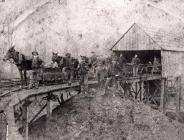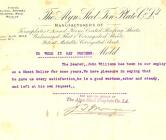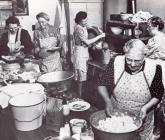Working Abroad - Welsh migration
Items in this story:
Welsh industrial migration: The legacy
In the nineteenth and twentieth centuries, millions of people across the world moved to different countries looking for work. They wanted to improve their lives, try new working practices, or have adventures in different lands.
Many people left Wales and took traditional Welsh industrial skills with them. Some helped create continuing economic success in the countries they moved to. Some made huge fortunes, finding fame. Others led more quietly successful lives, settling down and raising families. Some returned to Wales after time abroad, others were never to see this country again.
Here we look at the various industries from Wales that supplied workers and expertise around the world. What were those industries and skills? Where did the workers go? What values and traditions did they take with them? What impact did their leaving have on the country they left behind?
Coal
Wales experienced a spectacular boom in coal mining in the late 19th and early 20th centuries. The world looked to the Welsh mining industry for expertise and advice.
As other countries developed their own economies they also began to exploit local sources of coal. The skills of Welsh miners led to them being recruited by foreign mining companies. The miners were offered generous wages to develop and manage foreign mines.
Welsh miners were found in large communities in the coalfields of Australia and America. Welsh mining engineers helped to develop the industry in South Africa and even China, which is, today, the largest producer and user of coal in the world.
Welsh miners were also to be found in England. There was a large Welsh community in Kent, where the coalfield was developed in the early 20th century.
The most important areas of coal production by Welsh miners outside of Wales were in the states of Ohio and Pennsylvania, in the USA.
The town of Scranton in Pennsylvania became the centre of the largest concentration of Welsh people outside Wales. Many street names reflect the Welsh heritage of the area, for example, Jones Street, Evans Court and Eynon Street.
Chapels were common and built in the Welsh style and the Welsh language was in common use, supported in the chapels and eisteddfodau as well as newspapers.
Even when financial backers of mines were not Welsh or of Welsh descent they often preferred to employ experienced Welsh mine managers. These, in turn, tended to employ Welsh miners.
Although this often created a strong camaraderie among the Welsh in the mines it sometimes caused difficulties among miners of other nationalities working alongside them.
Copper
The world of copper smelting was led by Wales in the 19th century. The works around Swansea and Holywell supplied over 50% of the world's copper.
The US copper industry vastly outstripped the Welsh copper industry. In Australia there were huge deposits of copper ore which led to the growth of smelting towns around the Spencer Gulf, South Australia from the 1860s. The workers were migrants, almost exclusively from the Swansea region, in the early days.
The mine and smelting works in Burra Burra, South Australia were Welsh owned with workers recruited in the Loughor and Llanelli area. It was the establishment of these smelters that eventually broke Swansea's undisputed dominance over the world copper markets.
As British and European copper sources became depleted, Swansea began to import copper ore, from countries such as Chile. In the 1860s Welsh smelters helped to establish works in Chile and today that country is among the largest producers in the world.
Gold
Gold has been mined intermittently in Wales for thousands of years, but the industry never employed huge numbers of workers. Despite this, many Welsh emigrants joined the famous 'Gold Rushes' of the 19th century.
Gold discovered in parts of the USA, Canada and Australia attracted people from all over the world. Many found very little and gave up prospecting to turn to other employment or to return home. A few made a passable living from gold; even fewer made a very large amount of money.
George Hall was born near Hay on Wye in 1855. He developed the Gwalia series of gold mines in Western Australia in the 1890s. The mines made a huge profit for his employers and Hall made a personal fortune himself albeit with some dubious business deals.
Harry Jones from north Wales had a more typical story. He emigrated to British Columbia, Canada in 1862 with 'The Company of Welsh Adventurers'. He continued prospecting for gold there until he died in the 1930s aged 95.
Iron
Wales was at the forefront of the development of the iron industry in Britain and it is therefore not surprising to find Welsh people leading the industry across the world in the nineteenth century.
John Vaughan of the Dowlais ironworks became a manager at Newcastle upon Tyne, England. There he met a German accountant called Henry Bolckow. Together, they are credited with founding the Cleveland iron industry.
The company of Bolckow Vaughan employed many Welshmen. These included Edward Williams, grandson of the bard Iolo Morganwg. Williams eventually owned another ironworks and became mayor of Middlesbrough.
In the USA, Ohio and Pennsylvania became central to the iron industry attracting many Welsh immigrants. Not all of these had trained in the foundries of Wales however. In southern Ohio many ironworks were started by agricultural emigrants from rural Cardiganshire.
The modern Ukrainian city of Donetsk began as the iron working town of Hughesovska, founded by John Hughes of Merthyr Tydfil. Many Welsh workers were employed there from 1869 until they were expelled during the Russian Revolution of 1917.
Slate
Slate was used in Europe as a roofing material. Welsh slate was exported across the world for prestigious building projects. The discovery of slate deposits in different countries became one of a number of economic factors that influenced Welsh workers to move to those areas.
The heartland of Welsh slate is in the northwest of the country and it was from that area that most slate workers emigrated. Between 1845 and 1851 nearly 1500 people left the towns of Bethesda and Llanberis for the slate quarries of Vermont, USA alone. There were also large slate communities in the states of Pennsylvania and New York, centred around the towns of Granville and Fair Haven. At least six other states had slate industries, all worked mainly by Welsh immigrants.
There were slate quarries in Newfoundland, Canada and Tasmania, Australia that attracted Welsh workers from the mid-nineteenth century. Richard Jones, a slate quarry manager from Bethesda even emigrated to Prussia (now north-east Germany) in 1857.
Steel
Iron working centres often adapted themselves to the creation of steel, a stronger, more versatile material. Unsurprisingly Welsh workers played an important part in this change.
In Middlesbrough, England, the Welsh owned company of Bolckow Vaughan was the single largest producer of steel in the world between 1885 and 1914.
In the USA, the iron-producing heartlands of Pennsylvania and Ohio also turned to steel production. Samuel J Evans, a tinplate worker from Betws in Carmarthenshire, emigrated in 1899 to Aliquippa, Pennsylvania where he worked in the steel mill as a rollerman. He married Bess Parry, who was born in Pennsylvania to Welsh parents.
Steel industries developed, with the assistance of Welsh workers, in Australia and other countries. These in turn caused a decline in the Welsh steel industry as demand for exports dropped. Welsh workers were then forced to emigrate to look for further work in the industry although their skills and techniques were considered dated and less in demand by the 1950s.
Shipping
Wales has a 1,200km (750 mile) coastline and a long tradition of seafaring. Welsh sailors travelled around the world, exporting Welsh goods and importing raw materials for industry. Welsh shipping lines were among the best-known in maritime trade and the company owners were amongst the richest.
With the large and important Atlantic port of Liverpool being so close to north Wales, it is no surprise to find that a number of important shipowners in the city were Welsh.
Sir Alfred Lewis Jones, originally of Carmarthenshire, was an apprentice at the African Steamship Company from the age of 12 in 1857. By 1900 he owned the majority of the company. He founded the Liverpool School of Tropical Medicine.
By the nature of their work, Welsh mariners travelled the world and many of them settled in other countries. William Jones of Newborough in Anglesey sailed on his uncle's ships to Australia and settled in Burnie, Tasmania in 1872 aged 30. He became the most prominent shipowner and industrialist in the area.
Metal Mining
Welsh people were renowned for their mining expertise. As well as coal, they were experienced at excavating gold, iron, lead and copper ores.
As frontiers opened up in developing countries, Welsh miners were often to be found at the forefront. As well as miners, Wales provided some of the most experienced mine managers and engineers in the world. Demand for their skills led to the payment of good wages.
Welsh miners were second in number only to Cornishmen in the metal mines of the western USA.
Some metal mines in India and South Africa were developed by Welsh lead miners in the late 19th century. Both countries were part of the British Empire at the time and the declining lead industries in Wales meant there were people looking for opportunities in new areas.
The widening search for copper ores led Welsh companies to open new mines in Newfoundland, Canada and Cape Colony, South Africa.
Tinplate
The manufacture of tinplate was another area where Wales held a virtual monopoly in the world. South Wales accounted for over 80% of world production in the early 1890s.
The Welsh industry hit a crisis in 1891 when the USA imposed the 'McKinley Tariff'. This protectionist tariff was charged on imported goods, making them uncompetitive with American-produced goods. Many Welsh works temporarily closed or cut their production and their workforce. At the same time, demand for skilled tinplate workers rose in America leading to much emigration.
Lewis and David John Thomas, tinplate workers from Pantyffynnon, Carmarthenshire met for a fnal time with their friends in 1895. The meeting was recalled in the journal Industrial World:
'There's no need to say where the two brothers were heading, because so many of the Alcan-workers of Wales are heading west, just as the cockles congregate on Penclawdd beach... Many Welsh have left their native land for America, and that for various reasons...'
Other Industries
Not all Welsh people worked in the 'traditional' heavy industries of Wales of course. Many worked in other industries and many transferred the skills they learnt in mines, foundries and works to other places of work. They also took their skills overseas and left their mark in other countries.
Welsh hospitality seems to have travelled well and many bars and inns were run by Welsh people. The famous Ellis Island in New York, first landing point for millions of migrants to America, was named after Samuel Ellis, a Welshman who owned an inn there in the 18th century.
The Welsh abroad became well known for supplying teachers, preachers and politicians to their communities. The seventh Prime Minister of Australia, William Morris Hughes, was raised in Llandudno on his aunt's farm. William Meirion Evans, a slate quarryman from Gwynedd moved to the copper mines of South Australia. He became the first Welsh preacher on the continent. After ordination as a minister in the USA, he returned to Australia where he continued preaching while also editing two Welsh-language newspapers.
Migration patterns
Not everyone who left Wales for a new life abroad stayed away. Many people returned home for various reasons. This is called back migration.
In Porth, in the Rhondda Valley, there is an area known as America Fach (Little America). Many residents of the area, in the 19th century, had spent time living in the USA before returning to Wales. The local pub is called The New York.
In the 19th century, a lower percentage of people from Wales emigrated than from Ireland, Scotland or England. Welsh people also showed higher levels of returning home than other Britons. Various reasons have been suggested for this. It is probable that the high levels of industrial employment in Wales allowed for more people to return home during times of economic success.
Another theory is rooted in the concept called hiraeth in Welsh. This is a longing to be in Wales which draws people back to the country.
Some people seem to have got a taste for the migrant lifestyle. Many left Wales for a short time and then returned home, only to set off again to a different location.
When people moved abroad to look for work they usually had a destination in mind. Often there was a job guaranteed for them, family and friends already there and a community of people from their home country. Sometimes however they moved on again, perhaps several times, before they settled in one place. This is called stage migration.
Abraham T. Lewis was born in Brymbo, an iron and coal town near Wrexham in 1840. He moved to Hanley, Staffordshire and then Shenandoah, Pennsylvania, USA, which were also coal towns. In 1879 he moved to the silver mining town of Russell Gulch in Colorado. He later moved north to Washington Territory and then to Nanaimo, Canada. There he resumed coal mining and died in a colliery explosion in 1887.
It was common for one member of a family to go abroad and then others to follow when he had found work and housing. This is called chain migration.
Wives and children often travelled several months or even years after the men. Brothers, sisters, parents, friends and neighbours were sometimes persuaded to emigrate by news from overseas.
Radicalism
Welsh industrial workers came from areas that had well organised unions. They had a reputation for standing up for their rights, safe working conditions and decent pay. When they left Wales to work abroad they took that reputation — and the fight — with them.
John Owens emigrated from Clydach Vale to Ohio, USA, as a child in the 1890s. He lost a leg in an accident and occupied himself with union work. By the 1930s he was president of the United Mine Workers of America for Ohio. After World War Two he was International Secretary Treasurer of UMWA until 1970. Owens created the USA's first workers health and welfare system.
Welsh radicalism has been blamed for the troubles of the British car manufacturing industry in the late 1970s, although most of the factories were located outside Wales.
Many employees in the car factories of Oxford and Birmingham were Welsh. They had emigrated, looking for work as the traditional Welsh industries struggled in economic depression before and after World War Two.
In America this reputation for militancy prejudiced some employers against Welsh workers.
Welsh Culture
Like many emigrants, Welsh people took their culture with them to the new countries. In a strange, new place, keeping the songs, stories, languages and traditions of home alive helped emigrants to deal with the unfamiliarity.
The centre of Welsh life in many towns and villages was the chapel. As well as a religious function, chapel buildings served as community halls, welfare centres and temporary shelters for new arrivals. The architecture of chapels in Welsh communities abroad was often identical to that at home.
Sunday Schools and Bible reading led to a high degree of literacy among Welsh emigrants. The use of the Welsh language was common in all communities where the Welsh settled in numbers, and could be passed on for generations. From 1851, Y Drych ('The Mirror') was published, one of a number of Welsh-language newspapers for Americans.
The eisteddfod is the pinnacle of Welsh cultural celebrations and many were held in towns across the world where Welsh communities existed.
Women
The majority of industrial workers were men but women of course formed an important part of migrant communities. Often the men would travel ahead to a new country, to secure work and housing. They would then send for their wives and families to join them. The women had to support themselves and their children in the meantime and then make the long journey themselves. Women were very prominent in organizing community activities such as eisteddfodau, schooling and social reforms.
Some women did work in industry. In Wales women were widely employed in tinplate works. In 1895 the Monongahela Tin Plate works in Pittsburgh, Pennsylvania employed a Welsh immigrant called Hattie Williams to train women for what was seen in America as men's work. This led to protests on both sides of the Atlantic.
Women also played a part in other aspects of commercial life. In New Zealand, Mary Jane Innes (neé Lewis) of Llanvaches, Monmouthshire successfully ran her late husband's brewery business for many years.
Place names
It was common for emigrants of all nationalities to name their new settlements after places in their home countries. This provided a sense of identity and a link with home.
It is possible to trace the origins of many place names around the world through the links of their founders.
In the slate areas of Pennsylvania, USA, the town of Bangor was named by Robert Jones, after his home town. He encouraged many others from north Wales to emigrate to the area and work in his slate quarries. In fact there are at least 15 Bangors in the USA, another 3 in Australia and 4 more in Canada.
The town of Bryn Mawr in Pennsylvania, home to a famous college, is not named for the town in Blaenau Gwent. Its founder Rowland Ellis came from Dolgellau and brought with him the name of his family farm.
Some places, such as Swansea in Ontario, Canada, take their names from the landscape being so similar to that around the original Welsh town.















